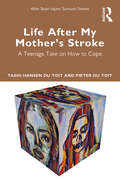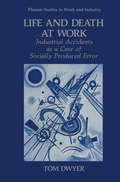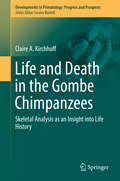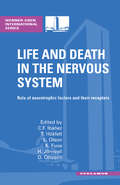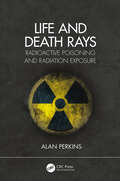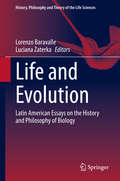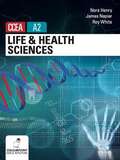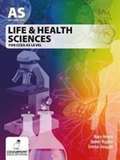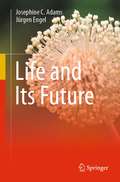- Table View
- List View
Life After Encephalitis: A Narrative Approach (After Brain Injury: Survivor Stories)
by Ava EastonEncephalitis is a devastating condition whose impact upon people should not be underestimated. It robs people of abilities most of us take for granted, it leaves people without their loved ones, and even in those families where the person affected survives the person they once knew can be dramatically changed. Life After Encephalitis provides a unique insight into the experiences of those affected by encephalitis, sharing the rich, perceptive, and often powerful, narratives of survivors and family members. It shows how listening to patient and family narratives can help us to understand how they make sense of what has happened to them, and also help professionals better understand and engage with them in practice. The book will also be useful for considering narratives associated with brain injuries from other causes, for example traumatic brain injury. Life After Encephalitis will appeal to a wide range of professionals working in rehabilitation settings, and also to and survivors of encephalitis, their families, and carers.
Life After Encephalitis: A Narrative Approach (After Brain Injury: Survivor Stories)
by Ava EastonEncephalitis is a devastating condition whose impact upon people should not be underestimated. It robs people of abilities most of us take for granted, it leaves people without their loved ones, and even in those families where the person affected survives the person they once knew can be dramatically changed. Life After Encephalitis provides a unique insight into the experiences of those affected by encephalitis, sharing the rich, perceptive, and often powerful, narratives of survivors and family members. It shows how listening to patient and family narratives can help us to understand how they make sense of what has happened to them, and also help professionals better understand and engage with them in practice. The book will also be useful for considering narratives associated with brain injuries from other causes, for example traumatic brain injury. Life After Encephalitis will appeal to a wide range of professionals working in rehabilitation settings, and also to and survivors of encephalitis, their families, and carers.
Life After My Mother’s Stroke: A Teenage Take on How to Cope (After Brain Injury: Survivor Stories)
by Tashi Hansen du Toit Pieter du ToitTashi Hansen du Toit was 15 years old when her mother, Karen, suffered a severe haemorrhagic stroke which left her with multiple physical and cognitive impairments. This beautifully written and poignant account tells Tashi’s story from the first moments after her mother’s stroke, following her and her family through the experience of her mother’s hospitalisation and rehabilitation. Tashi offers a rare glimpse into the impact of her mother’s stroke on her family and on her life as a teenager as she juggles the stresses and demands of family, school, and friends alongside coping with her mother’s brain injury. As she describes how she is learning to cope with her unresolved grief three years on, she provides hope, perspective, and insight on how to work towards growth and acceptance despite the catastrophe of a parent’s stroke. Presenting the rarely heard adolescent perspective on parental brain injury, Tashi’s moving story also features Karen’s account as she comes to terms with her experience. This authentic book offers great support to others, particularly teenagers, who may be going through a similar experience. It is also valuable reading for those working in brain injury services and the education system, and for any professional or student involved in neurorehabilitation or supporting families of parents with brain injury.
Life After My Mother’s Stroke: A Teenage Take on How to Cope (After Brain Injury: Survivor Stories)
by Tashi Hansen du Toit Pieter du ToitTashi Hansen du Toit was 15 years old when her mother, Karen, suffered a severe haemorrhagic stroke which left her with multiple physical and cognitive impairments. This beautifully written and poignant account tells Tashi’s story from the first moments after her mother’s stroke, following her and her family through the experience of her mother’s hospitalisation and rehabilitation. Tashi offers a rare glimpse into the impact of her mother’s stroke on her family and on her life as a teenager as she juggles the stresses and demands of family, school, and friends alongside coping with her mother’s brain injury. As she describes how she is learning to cope with her unresolved grief three years on, she provides hope, perspective, and insight on how to work towards growth and acceptance despite the catastrophe of a parent’s stroke. Presenting the rarely heard adolescent perspective on parental brain injury, Tashi’s moving story also features Karen’s account as she comes to terms with her experience. This authentic book offers great support to others, particularly teenagers, who may be going through a similar experience. It is also valuable reading for those working in brain injury services and the education system, and for any professional or student involved in neurorehabilitation or supporting families of parents with brain injury.
Life, Almost: Miscarriage, misconceptions and a search for answers from the brink of motherhood
by Jennie Agg'Vital and heart-wrenchingly intimate' Leah Hazard'Urgent, fascinating and thought-provoking' Julia Bueno'Thoughtfully researched and beautifully written' Pippa VosperAfter losing four pregnancies with no obvious cause, Jennie Agg set out to understand why miscarriage remains such a profoundly misunderstood, under-researched and under-acknowledged experience.Part-memoir, part-scientific investigation, Life, Almost documents Agg's path to motherhood and her search for answers. Tracing each tentative step of her fifth pregnancy - as her body becomes a creature she does not wish to spook - Agg dismantles the myths that we unquestioningly accept about our reproductive lives:· Why are we told miscarriage can't be prevented when half of all miscarriages are of perfectly healthy embryos?· Why is it normal not to tell anyone you're pregnant for the first three months? · Why don't we know why labour starts? Drawing on pioneering research and interviews with world-leading experts, Life, Almost is a ground-breaking book that will change how you think about miscarriage, and a moving reflection on grief and love at the edge of life as we understand it.
A Life and Career in Chemistry: Autobiography from the 1960s to the 1990s
by Pierre LaszloThis book is an enthusiastic account of Pierre Laszlo’s life and pioneering work on catalysis of organic reactions by modified clays, and his reflections on doing science from the 1960s to 1990s. In this autobiography, readers will discover a first-hand testimony of the chemical revolution in the second half of the 20th century, and the author’s perspective on finding a calling in science and chemistry, as well as his own experience on doing science, teaching science and managing a scientific career.During this period, Pierre Laszlo led an academic laboratory and worked also in three different countries: the US, Belgium and France, where he had the opportunity to meet remarkable colleagues. In this book, he recalls his encounters and collaborations with important scientists, who shaped the nature of chemistry at times of increased pace of change, and collates a portrait of the worldwide scientific community at that time. In addition, the author tells us about the turns and twists of his own life, and how he ended up focusing his research on clay based chemistry, where clay minerals were turned in his lab to catalysis of key chemical transformations. Given its breath, the book offers a genuine information on the life and career of a chemist, and it will appeal not only to scientists and students, but also to historians of science and to the general reader.
Life and Death at Work: Industrial Accidents as a Case of Socially Produced Error (Springer Studies in Work and Industry)
by Tom DwyerLife and Death in the Gombe Chimpanzees: Skeletal Analysis as an Insight into Life History (Developments in Primatology: Progress and Prospects)
by Claire A. KirchhoffThis book addresses how skeletons can inform us about behavior by describing skeletal lesions in the Gombe chimpanzees, relating them to known life histories whenever possible, and analyzing demographic patterns in the sample. This is of particular interest to both primatologists and skeletal analysts who have benefited from published data on a smaller, earlier skeletal sample from Gombe. The Gombe skeletal collection is the largest collection of wild chimpanzees with known life histories in existence, and this work significantly expands the skeletal sample from this long-term research site (49 chimpanzees). The book explores topics of general interest to skeletal analysts such as demographic patterns, which injuries leave signs on the skeleton, and rates of healing, and discusses both qualitative and quantitative analysis of the patterning of lesions. The book presents the data in a narrative style similar to that employed in Dr. Goodall’s seminal work The Chimpanzees of Gombe. Readers already familiar with the Gombe chimpanzees are likely to appreciate summaries of life events correlated to observable skeletal features. The book is especially relevant at this time to remind primate conservationists of the importance of the isolated chimpanzee population at Gombe National Park as well as the availability of the skeletons for study, both within the park itself as well as at the University of Minnesota.
Life and Death in the Nervous System: Role of Neurotrophic Factors and Their Receptors
by C.F. IBÁÑEZ, T. HÖKFELT, L. OLSON, K. FUXE, H. JÖRNVALL, D. OTTOSONLife and Death in the Nervous System
Life and Death of the Stars (Undergraduate Lecture Notes in Physics)
by Ganesan SrinivasanThis volume is devoted to one of the fascinating things about stars: how they evolve as they age. This evolution is different for stars of different masses. How stars end their lives when their supply of energy is exhausted also depends on their masses. Interestingly, astronomers conjectured about the ultimate fate of the stars even before the details of their evolution became clear. Part I of this book gives an account of the remarkable predictions made during the 1920s and 1930s concerning the ultimate fate of stars. Since much of this development hinged on quantum physics that emerged during this time, a detailed introduction to the relevant physics is included in the book. Part II is a summary of the life history of stars. This discussion is divided into three parts: low-mass stars, like our Sun, intermediate-mass stars, and massive stars. Many of the concepts of contemporary astrophysics were built on the foundation erected by Subrahmanyan Chandrasekhar in the 1930s. This book, written during his birth centenary, includes a brief biographical sketch of the brilliant scientist, which readers will find fascinating.Reading this book will get young students excited about the presently unfolding revolution in astronomy and the challenges that await them in the world of physics, engineering and technology. General readers will also find the book appealing for its highly accessible narrative of the physics of stars.This book is a companion volume of “What are the Stars?” by the same author."I know of no other book on the evolution of stars of a similar scope and breadth that is so accessible for undergraduate students."E P J van den HeuvelProfessor of AstrophysicsWinner of the Spinoza and Descartes PrizesUniversity of Amsterdam, The Netherlands
Life and Death Rays: Radioactive Poisoning and Radiation Exposure
by Alan PerkinsThis unique book provides an accessible introduction to both the scientific background and the key people involved in the discovery and use of radiation and radioactivity. It begins by providing a short history of radiation exposures and radiation poisoning; from the early inappropriate use of X-rays and radium cures through the misadventures of the Manhattan Project and the Chernobyl disaster, to the high-profile and deliberate poisoning of Alexander Litvinenko in London with polonium-210, which gave rise to worldwide media attention. The chapters provide a catalogue of deliberate criminal acts, unfortunate accidents, and inadvertent radiation exposures, exploring well-known events in detail, as well as some not so well-known occurrences. It works through the topics by focusing on human stories and events and their biological impact. In addition, it covers descriptions of the beneficial uses of radiation and radioactivity. This book can be enjoyed by any reader with a general interest in science, as well as by students and professionals within the scientific and medical communities. Key features Authored by a subject area specialist who has worked in both clinical practice and academia and was involved with the national media following incidents of national and international importance Provides a unique human perspective into well-known and some lesser known events and a concise history of the discovery of radiation and the events that followed Adds scientific and medical background to a subject of high media interest
Life and Death Rays: Radioactive Poisoning and Radiation Exposure
by Alan PerkinsThis unique book provides an accessible introduction to both the scientific background and the key people involved in the discovery and use of radiation and radioactivity. It begins by providing a short history of radiation exposures and radiation poisoning; from the early inappropriate use of X-rays and radium cures through the misadventures of the Manhattan Project and the Chernobyl disaster, to the high-profile and deliberate poisoning of Alexander Litvinenko in London with polonium-210, which gave rise to worldwide media attention. The chapters provide a catalogue of deliberate criminal acts, unfortunate accidents, and inadvertent radiation exposures, exploring well-known events in detail, as well as some not so well-known occurrences. It works through the topics by focusing on human stories and events and their biological impact. In addition, it covers descriptions of the beneficial uses of radiation and radioactivity. This book can be enjoyed by any reader with a general interest in science, as well as by students and professionals within the scientific and medical communities. Key features Authored by a subject area specialist who has worked in both clinical practice and academia and was involved with the national media following incidents of national and international importance Provides a unique human perspective into well-known and some lesser known events and a concise history of the discovery of radiation and the events that followed Adds scientific and medical background to a subject of high media interest
Life and Evolution: Latin American Essays on the History and Philosophy of Biology (History, Philosophy and Theory of the Life Sciences #26)
by Lorenzo Baravalle Luciana ZaterkaThis book offers to the international reader a collection of original articles of some of the most skillful historians and philosophers of biology currently working in Latin American universities. During the last decades, increasing attention has been paid in Latin America to the history and philosophy of biology, but since many local authors prefer to write in Spanish or in Portuguese, their ideas have barely crossed the boundaries of the continent. This volume aims to remedy this state of things, providing a good sample of this production to the English speaking readers, bringing together contributions from researchers working in Brazilian, Argentinean, Chilean, Colombian and Mexican universities. The stress on the regional provenance of the authors is not intended to suggest the existence of something like a Latin American history and philosophy of biology, supposedly endowed with distinctive features. On the contrary, the editors firmly believe that advances in this field can be achieved only by stimulating the integration in the international debate. Based on this assumption, the book focuses on two topics, life and evolution, and presents a selection of contributions addressing issues such as the history of the concept of life, the philosophical reflection on life manipulation and life extension, the structure and development of evolutionary theory as well as human evolution. Life and Evolution – Latin American Essays on the History and Philosophy of Biology will provide the international reader with a rather complete picture of the ongoing research in the history and philosophy of biology in Latin America, offering a snapshot of this dynamic community. It will also contribute to contextualize and develop the debate concerning life and evolution, and the relation between the two phenomena.
The Life and Fate of the Indian Tiger (Non-ser.)
by Tobias J. LanzThere may be no more magnificent animal than the tiger. Yet, around the world, their populations are dwindling, and the Indian Bengal tiger is no exception. Wild Bengal tigers dwell in tropical jungles, brush, marsh lands, and tall grasslands in Bangladesh, Nepal, India, Bhutan, and Burma, hunting prey such as pigs, deer, antelope, and buffalo. Some estimates say there are fewer than 2,000 Bengal tigers and the entire world tiger population may be less than 3,000.The Life and Fate of the Indian Tiger offers a unique perspective on these exquisite cats. Author Tobias J. Lanz, who has been studying Indian tigers since 1998, incorporates historical and cultural topics, as well as conservation and social theories into his narrative. He paints a detailed portrait of the tiger's life in the wild, enriching that picture with descriptions of the plant, animal, and human life found in India's diverse tiger habitats. The book also looks at tigers in myth and religion, tiger hunting, and the rise of conservation.Each engaging chapter is a combination of social and historical narrative, interspersed with the author's personal observations and analyses of places, people, and events. Knowledge gained from his research on Indian history, geography, politics, and religion is matched with the personal experiences he had while travelling across the subcontinent to visit tiger sanctuaries. Personal observations on local cultures, scenery, and wildlife are balanced by discussions with the Indian people, ranging from government officials to villagers. The Indian tiger continues to survive against great odds. Written in part to engage the reader in conservation efforts, The Life and Fate of the Indian Tiger outlines the main programs and policies enacted to save the tiger in India. Lanz dedicates a final chapter to global efforts at tiger conservation, explaining what can and must be done to safeguard the future of one of the world's rarest and most beautiful creatures.
Life And Health Sciences for CCEA A2 (PDF)
by Nora Henry James NapierThis textbook provides the first resource to address the examined units of the CCEA A2 level Life and Health Sciences specification. It covers both the Single and Double Award courses, through the study of the following units: A2 2: Organic Chemistry, A2 3: Medical Physics, A2 4: Sound and Light, A2 5: Genetics, Gene Technology and Stem Cells. The full-colour, illustrated chapters clearly explain the theory for the course, and are supported by worked examples, tips, examination-style questions and answers. The authors are all experienced science teachers and examiners. The book has been through a meticulous quality assurance process prior to publication.
Life And Health Sciences For CCEA AS Level
by Nora Henry James Napier Emma DouganDeveloped specifically to meet the requirements of the new CCEA GCE Life and Health Sciences AS course covering both the Single and Double Award. Contains numerous diagrams, exam tips, worked examples and questions, with answers supplied. Book contents covers the units AS 2, AS 3 and AS 5.
Life and Its Future
by Josephine C. Adams Jürgen EngelThis book is aimed at those who wish to understand more about the molecular basis of life and how life on earth may change in coming centuries. Readers of this book will gain knowledge of how life began on Earth, the natural processes that have led to the great diversity of biological organisms that exist today, recent research into the possibility of life on other planets, and how the future of life on earth faces unprecedented pressures from human-made activities. Readers will obtain a perspective on the potential risks of chemical or nuclear warfare, and the ever-increasing risks from human activities that are causing pollution and climate change with global heating. Readers will also learn about ongoing research efforts to generate “designer lifeforms” through synthetic biology and applications of artificial intelligence. The book makes an integrated, up-to-date, overview of topics often considered as separate fields. It should be valuable to students, teachers, and people who are concerned about the future of life.
Life and Mind: New Directions in the Philosophy of Biology and Cognitive Sciences (Interdisciplinary Evolution Research #8)
by José Manuel Viejo Mariano SanjuánThis volume provides a broad overview of some cutting-edge philosophical topics of growing interest at the juncture between cognitive science and biology. The main goal is not to integrate the variety of approaches into a single account, but rather to offer diverse perspectives on a collection of selected biological issues of particular philosophical relevance, reflecting the plurality of current research in these areas. Four conceptual vectors give this volume its coherence: Animal and human cognition: With respect to animal cognition, this volume focuses on self-awareness and methodological flaws in the science of animal consciousness. Regarding human cognition, the authors of this volume address various aspects of so-called 4E cognition. Genetics: The role of genes in the development of mind and life has always been philosophically controversial. In this volume, the authors address the possibility of considering post-genomic genes as natural kinds and the proper analysis of the concept of genotype. Teleology: This volume addresses issues of evolutionary causality and teleosemantics, as well as questions relating to biological teleology and regulation. Evolution: Evolution exemplifies better than any other concept the convergence point between philosophy, biology and cognitive sciences. Among other things, the volume deals with the origin of novelties in evolutionary processes from various viewpoints (e.g., cultural evolution and developmental plasticity). Despite their disparity, all these topics belong to a common naturalistic framework. By presenting them in a single volume, the editors want to emphasize the need to always conduct philosophical research on mind and life with tangential domains in mind.This book is a valuable resource for students and researchers of philosophy with a special interest in life, cognition, and evolution, as well as for biologists and cognitive scientists.
Life and Research: A Survival Guide for Early-Career Biomedical Scientists (Chicago Guides to Academic Life)
by Paris H. Grey David G. OppenheimerLife in a research lab can be daunting, especially for early-career scientists. Personal and professional hurdles abound in bench research, and this book by two seasoned lab professionals is here to help graduate students, postdocs, and staff scientists recognize stumbling blocks and avoid common pitfalls. Building and maintaining a mentoring network, practicing self-care and having a life outside of the lab, understanding that what works perfectly for a labmate might not work for you—these are just a few of the strategies that lab manager and molecular biologist Paris H. Grey and PI and geneticist David G. Oppenheimer wished they had implemented far sooner in their careers. They also offer practical advice on managing research projects, sharing your work on social media, and attending conferences. Above all, they coach early-career scientists to avoid burnout and make the most of every lab experience to grow and learn.
Life and Research: A Survival Guide for Early-Career Biomedical Scientists (Chicago Guides to Academic Life)
by Paris H. Grey David G. OppenheimerLife in a research lab can be daunting, especially for early-career scientists. Personal and professional hurdles abound in bench research, and this book by two seasoned lab professionals is here to help graduate students, postdocs, and staff scientists recognize stumbling blocks and avoid common pitfalls. Building and maintaining a mentoring network, practicing self-care and having a life outside of the lab, understanding that what works perfectly for a labmate might not work for you—these are just a few of the strategies that lab manager and molecular biologist Paris H. Grey and PI and geneticist David G. Oppenheimer wished they had implemented far sooner in their careers. They also offer practical advice on managing research projects, sharing your work on social media, and attending conferences. Above all, they coach early-career scientists to avoid burnout and make the most of every lab experience to grow and learn.
The Life and Science of Harold C. Urey (Synthesis)
by Matthew ShindellHarold C. Urey (1893–1981), whose discoveries lie at the foundation of modern science, was one of the most famous American scientists of the twentieth century. Born in rural Indiana, his evolution from small-town farm boy to scientific celebrity made him a symbol and spokesman for American scientific authority. Because he rose to fame alongside the prestige of American science, the story of his life reflects broader changes in the social and intellectual landscape of twentieth-century America. In this, the first ever biography of the chemist, Matthew Shindell shines new light on Urey’s struggles and achievements in a thoughtful exploration of the science, politics, and society of the Cold War era. From Urey’s orthodox religious upbringing to his death in 1981, Shindell follows the scientist through nearly a century of American history: his discovery of deuterium and heavy water earned him the Nobel Prize in 1934, his work on the Manhattan Project helped usher in the atomic age, he initiated a generation of American scientists into the world of quantum physics and chemistry, and he took on the origin of the Moon in NASA’s lunar exploration program. Despite his success, however, Urey had difficulty navigating the nuclear age. In later years he lived in the shadow of the bomb he helped create, plagued by the uncertainties unleashed by the rise of American science and unable to reconcile the consequences of scientific progress with the morality of religion. Tracing Urey’s life through two world wars and the Cold War not only conveys the complex historical relationship between science and religion in the twentieth century, but it also illustrates how these complexities spilled over into the early days of space science. More than a life story, this book immerses readers in the trials and triumphs of an extraordinary man and his extraordinary times.
The Life and Science of Harold C. Urey (Synthesis)
by Matthew ShindellHarold C. Urey (1893–1981), whose discoveries lie at the foundation of modern science, was one of the most famous American scientists of the twentieth century. Born in rural Indiana, his evolution from small-town farm boy to scientific celebrity made him a symbol and spokesman for American scientific authority. Because he rose to fame alongside the prestige of American science, the story of his life reflects broader changes in the social and intellectual landscape of twentieth-century America. In this, the first ever biography of the chemist, Matthew Shindell shines new light on Urey’s struggles and achievements in a thoughtful exploration of the science, politics, and society of the Cold War era. From Urey’s orthodox religious upbringing to his death in 1981, Shindell follows the scientist through nearly a century of American history: his discovery of deuterium and heavy water earned him the Nobel Prize in 1934, his work on the Manhattan Project helped usher in the atomic age, he initiated a generation of American scientists into the world of quantum physics and chemistry, and he took on the origin of the Moon in NASA’s lunar exploration program. Despite his success, however, Urey had difficulty navigating the nuclear age. In later years he lived in the shadow of the bomb he helped create, plagued by the uncertainties unleashed by the rise of American science and unable to reconcile the consequences of scientific progress with the morality of religion. Tracing Urey’s life through two world wars and the Cold War not only conveys the complex historical relationship between science and religion in the twentieth century, but it also illustrates how these complexities spilled over into the early days of space science. More than a life story, this book immerses readers in the trials and triumphs of an extraordinary man and his extraordinary times.
The Life and Science of Harold C. Urey (Synthesis)
by Matthew ShindellHarold C. Urey (1893–1981), whose discoveries lie at the foundation of modern science, was one of the most famous American scientists of the twentieth century. Born in rural Indiana, his evolution from small-town farm boy to scientific celebrity made him a symbol and spokesman for American scientific authority. Because he rose to fame alongside the prestige of American science, the story of his life reflects broader changes in the social and intellectual landscape of twentieth-century America. In this, the first ever biography of the chemist, Matthew Shindell shines new light on Urey’s struggles and achievements in a thoughtful exploration of the science, politics, and society of the Cold War era. From Urey’s orthodox religious upbringing to his death in 1981, Shindell follows the scientist through nearly a century of American history: his discovery of deuterium and heavy water earned him the Nobel Prize in 1934, his work on the Manhattan Project helped usher in the atomic age, he initiated a generation of American scientists into the world of quantum physics and chemistry, and he took on the origin of the Moon in NASA’s lunar exploration program. Despite his success, however, Urey had difficulty navigating the nuclear age. In later years he lived in the shadow of the bomb he helped create, plagued by the uncertainties unleashed by the rise of American science and unable to reconcile the consequences of scientific progress with the morality of religion. Tracing Urey’s life through two world wars and the Cold War not only conveys the complex historical relationship between science and religion in the twentieth century, but it also illustrates how these complexities spilled over into the early days of space science. More than a life story, this book immerses readers in the trials and triumphs of an extraordinary man and his extraordinary times.
The Life and Science of Harold C. Urey (Synthesis)
by Matthew ShindellHarold C. Urey (1893–1981), whose discoveries lie at the foundation of modern science, was one of the most famous American scientists of the twentieth century. Born in rural Indiana, his evolution from small-town farm boy to scientific celebrity made him a symbol and spokesman for American scientific authority. Because he rose to fame alongside the prestige of American science, the story of his life reflects broader changes in the social and intellectual landscape of twentieth-century America. In this, the first ever biography of the chemist, Matthew Shindell shines new light on Urey’s struggles and achievements in a thoughtful exploration of the science, politics, and society of the Cold War era. From Urey’s orthodox religious upbringing to his death in 1981, Shindell follows the scientist through nearly a century of American history: his discovery of deuterium and heavy water earned him the Nobel Prize in 1934, his work on the Manhattan Project helped usher in the atomic age, he initiated a generation of American scientists into the world of quantum physics and chemistry, and he took on the origin of the Moon in NASA’s lunar exploration program. Despite his success, however, Urey had difficulty navigating the nuclear age. In later years he lived in the shadow of the bomb he helped create, plagued by the uncertainties unleashed by the rise of American science and unable to reconcile the consequences of scientific progress with the morality of religion. Tracing Urey’s life through two world wars and the Cold War not only conveys the complex historical relationship between science and religion in the twentieth century, but it also illustrates how these complexities spilled over into the early days of space science. More than a life story, this book immerses readers in the trials and triumphs of an extraordinary man and his extraordinary times.
Life and Suicide Following Brain Injury: A Personal and Professional Account (After Brain Injury: Survivor Stories)
by Alyson NormanLife and Suicide Following Brain Injury tells the story of Tom, a 43 year-old man who acquired a brain injury from a road traffic accident at the age of 22. Tom survived but went on to take his own life 20 years later. As a vulnerable adult with mental health issues and long-term difficulties with substance misuse, this book tells Tom's story from his early childhood through to his death. In telling Tom's story, the author- a researcher in the brain injury field and Tom's sister- identifies the multiple suicide risk factors as well as the lack of understanding and inadequate service provision for people with complex needs following TBI. His story serves as a harrowing example of what can go wrong when timely intervention and support is not forthcoming, identifying a multitude of risk factors and possible points of intervention to improve care in the future. This book provides insight to professionals and academics across health and social care in the risks of suicide associated with TBI. It also provides support for those who have experienced the grief of losing a survivor to suicide, or those struggling to support a survivor who is suicidal.

